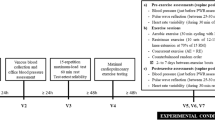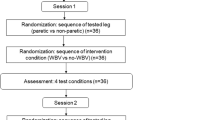Abstract
The augmentation index (AIx), a marker of wave reflection, decreases following acute leg exercise. Passive vibration (PV) causes local vasodilation that may reduce AIx. This study investigated the effects of acute PV on wave reflection and aortic hemodynamics. In a crossover fashion 20 (M=9, F=11) healthy young (22±3 year) participants were randomized to 10 min PV or no vibration control (CON) trials. Subjects rested in the supine position with their legs over a vibration platform for the entire session. Radial waveforms were obtained by applanation tonometry before and after 3 min (Post-3) and 30 min (Post-30) of PV (∼5.37 G) or CON. No change in parameters was found at Post-3. We found significant time-by-trial interactions (P<0.01) at Post-30 for augmented pressure, AIx and second systolic peak pressure (P2), such that these parameters significantly (P<0.05) decreased (−2.3±3.0 mm Hg, −7.2±6.9% and −1.5±3.5 mm Hg, respectively) after PV but not after CON. These findings suggest that acute PV applied to the legs decreases AIx owing to a decrease in wave reflection magnitude (P2). Further research is warranted to evaluate the potential clinical application of PV in populations at an increased cardiovascular risk who are unable to perform conventional exercise.
This is a preview of subscription content, access via your institution
Access options
Subscribe to this journal
Receive 12 digital issues and online access to articles
$119.00 per year
only $9.92 per issue
Buy this article
- Purchase on Springer Link
- Instant access to full article PDF
Prices may be subject to local taxes which are calculated during checkout

Similar content being viewed by others
References
Hashimoto J, Imai Y, O’Rourke MF . Indices of pulse wave analysis are better predictors of left ventricular mass reduction than cuff pressure. Am J Hypertens 2007; 20: 378–384.
O’Rourke MF, Adji A . An updated clinical primer on large artery mechanics: implications of pulse waveform analysis and arterial tonometry. Curr Opin Cardiol 2005; 20: 275–281.
Manisty C, Mayet J, Tapp RJ, Parker KH, Sever P, Poulter NH et al. Wave reflection predicts cardiovascular events in hypertensive individuals independent of blood pressure and other cardiovascular risk factors: an ASCOT (Anglo-Scandinavian Cardiac Outcome Trial) substudy. J Am Coll Cardiol 2010; 56: 24–30.
Safar ME, Blacher J, Protogerou A, Achimastos A . Arterial stiffness and central hemodynamics in treated hypertensive subjects according to brachial blood pressure classification. J Hypertens 2008; 26: 130–137.
Vlachopoulos C, Aznaouridis K, O’Rourke MF, Safar ME, Baou K, Stefanadis C . Prediction of cardiovascular events and all-cause mortality with central haemodynamics: a systematic review and meta-analysis. Eur Heart J 2010; 31 (15): 1865–1871.
Nichols WW . Clinical measurement of arterial stiffness obtained from noninvasive pressure waveforms. Am J Hypertens 2005; 18 (1 Pt 2): 3S–10S.
Mitchell GF . Arterial stiffness and wave reflection: biomarkers of cardiovascular risk. Artery Res 2009; 3 (2): 56–64.
Weber T, O’Rourke MF, Ammer M, Kvas E, Punzengruber C, Eber B . Arterial stiffness and arterial wave reflections are associated with systolic and diastolic function in patients with normal ejection fraction. Am J Hypertens 2008; 21 (11): 1194–1202.
Munir S, Jiang B, Guilcher A, Brett S, Redwood S, Marber M et al. Exercise reduces arterial pressure augmentation through vasodilation of muscular arteries in humans. Am J Physiol Heart Circ Physiol 2008; 294 (4): H1645–H1650.
Heffernan KS, Jae SY, Echols GH, Lepine NR, Fernhall B . Arterial stiffness and wave reflection following exercise in resistance-trained men. Med Sci Sports Exerc 2007; 39 (5): 842–848.
Figueroa A, Vicil F . Post-exercise aortic hemodynamic responses to low-intensity resistance exercise with and without vascular occlusion. Scand J Med Sci Sports 2011; 21 (3): 431–436.
Bogaerts AC, Delecluse C, Claessens AL, Troosters T, Boonen S, Verschueren SM . Effects of whole body vibration training on cardiorespiratory fitness and muscle strength in older individuals (a 1-year randomised controlled trial). Age Ageing 2009; 38 (4): 448–454.
Otsuki T, Takanami Y, Aoi W, Kawai Y, Ichikawa H, Yoshikawa T . Arterial stiffness acutely decreases after whole-body vibration in humans. Acta Physiol (Oxf) 2008; 194: 189–194.
Figueroa A, Vicil F, Sanchez-Gonzalez MA . Acute exercise with whole-body vibration decreases wave reflection and leg arterial stiffness. Am J Cardiovasc Dis 2011; 111 (7): 1261–1268.
Rittweger J, Mutschelknauss M, Felsenberg D . Acute changes in neuromuscular excitability after exhaustive whole body vibration exercise as compared to exhaustion by squatting exercise. Clin Physiol Funct Imaging 2003; 23: 81–86.
Roelants M, Verschueren SM, Delecluse C, Levin O, Stijnen V . Whole-body-vibration-induced increase in leg muscle activity during different squat exercises. J Strength Cond Res 2006; 20 (1): 124–129.
Figueroa A, Vicil F, Sanchez-Gonzalez MA . Acute exercise with whole-body vibration decreases wave reflection and leg arterial stiffness. Am J Cardiovasc Dis 2011; 1 (1): 60–67.
Lohman III EB, Petrofsky JS, Maloney-Hinds C, Betts-Schwab H, Thorpe D . The effect of whole body vibration on lower extremity skin blood flow in normal subjects. Med Sci Monit 2007; 13 (2): CR71–CR76.
Maloney-Hinds C, Petrofsky JS, Zimmerman G . The effect of 30 Hz vs. 50 Hz passive vibration and duration of vibration on skin blood flow in the arm. Med Sci Monit 2008; 14 (3): CR112–CR116.
Maloney-Hinds C, Petrofsky JS, Zimmerman G, Hessinger DA . The role of nitric oxide in skin blood flow increases due to vibration in healthy adults and adults with type 2 diabetes. Diabetes Technol Ther 2009; 11 (1): 39–43.
Ounis-Skali N, Mitchell GF, Solomon CG, Solomon SD, Seely EW . Changes in central arterial pressure waveforms during the normal menstrual cycle. J Investig Med 2006; 54 (6): 321–326.
Adkisson EJ, Casey DP, Beck DT, Gurovich AN, Martin JS, Braith RW . Central, peripheral and resistance arterial reactivity: fluctuates during the phases of the menstrual cycle. Exp Biol Med (Maywood) 2010; 235: 111–118.
O’Rourke MF, Pauca A, Jiang XJ . Pulse wave analysis. Br J Clin Pharmacol 2001; 51: 507–522.
Wilkinson IB, Hall IR, MacCallum H, Mackenzie IS, McEniery CM, van der Arend BJ et al. Pulse-wave analysis: clinical evaluation of a noninvasive, widely applicable method for assessing endothelial function. Arterioscler Thromb Vasc Biol 2002; 22 (1): 147–152.
Nichols WW, Singh BM . Augmentation index as a measure of peripheral vascular disease state. Curr Opin Cardiol 2002; 17 (5): 543–551.
Wilkinson IB, MacCallum H, Flint L, Cockcroft JR, Newby DE, Webb DJ . The influence of heart rate on augmentation index and central arterial pressure in humans. J Physiol 2000; 525 (Pt 1): 263–270.
McEniery CM, Yasmin, Hall IR, Qasem A, Wilkinson IB, Cockcroft JR . Normal vascular aging: differential effects on wave reflection and aortic pulse wave velocity: the Anglo-Cardiff Collaborative Trial (ACCT). J Am Coll Cardiol 2005; 46 (9): 1753–1760.
Clifford PS, Hellsten Y . Vasodilatory mechanisms in contracting skeletal muscle. J Appl Physiol 2004; 97: 393–403.
Nichols WW, O’Rourke MF . McDonald's Blood Flow in Arteries. Theoretical, Experimental and Clinical Principles. Arnold: London, 1998.
Munir S, Guilcher A, Kamalesh T, Clapp B, Redwood S, Marber M et al. Peripheral augmentation index defines the relationship between central and peripheral pulse pressure. Hypertension 2008; 51 (1): 112–118.
Takazawa K, Tanaka N, Takeda K, Kurosu F, Ibukiyama C . Underestimation of vasodilator effects of nitroglycerin by upper limb blood pressure. Hypertension 1995; 26: 520–523.
Herrero AJ, Martin J, Martin T, Garcia-Lopez D, Garatachea N, Jimenez B et al. Whole-body vibration alters blood flow velocity and neuromuscular activity in Friedreich's ataxia. Clin Physiol Funct Imaging 2011; 31: 139–144.
Rittweger J, Moss AD, Colier W, Stewart C, Degens H . Muscle tissue oxygenation and VEGF in VO-matched vibration and squatting exercise. Clin Physiol Funct Imaging 2010; 30 (4): 269–278.
Nakamura H, Okazawa T, Nagase H, Yoshida M, Ariizumi M, Okada A . Change in digital blood flow with simultaneous reduction in plasma endothelin induced by hand-arm vibration. Int Arch Occup Environ Health 1996; 68 (2): 115–119.
Kelly RP, Millasseau SC, Ritter JM, Chowienczyk PJ . Vasoactive drugs influence aortic augmentation index independently of pulse-wave velocity in healthy men. Hypertension 2001; 37 (6): 1429–1433.
Casey DP, Nichols WW, Braith RW . Impact of aging on central pressure wave reflection characteristics during exercise. Am J Hypertens 2008; 21: 419–424.
Hashimoto J, Nichols WW, O’Rourke MF, Imai Y . Association between wasted pressure effort and left ventricular hypertrophy in hypertension: influence of arterial wave reflection. Am J Hypertens 2008; 21: 329–333.
Hull JH, Ansley L, Bolton CE, Sharman JE, Knight RK, Cockcroft JR et al. The effect of exercise on large artery haemodynamics in cystic fibrosis. J Cyst Fibros 2011; 10: 121–127.
Acknowledgements
We would like to express our gratitude to Edzard Zeinstra and Power Plate International for providing technical support and the vibrating platform.
Author information
Authors and Affiliations
Corresponding author
Ethics declarations
Competing interests
The authors declare no conflict of interest.
Rights and permissions
About this article
Cite this article
Sanchez-Gonzalez, M., Wong, A., Vicil, F. et al. Impact of passive vibration on pressure pulse wave characteristics. J Hum Hypertens 26, 610–615 (2012). https://doi.org/10.1038/jhh.2011.63
Received:
Revised:
Accepted:
Published:
Issue Date:
DOI: https://doi.org/10.1038/jhh.2011.63
Keywords
This article is cited by
-
Effects of whole-body vibration or resistive-vibration exercise on blood clotting and related biomarkers: a systematic review
npj Microgravity (2023)
-
Acute passive vibration reduces arterial stiffness and aortic wave reflection in stroke survivors
European Journal of Applied Physiology (2014)
-
Nitrates and Arterial Function
Current Cardiovascular Risk Reports (2013)
-
Whole-body vibration training reduces arterial stiffness, blood pressure and sympathovagal balance in young overweight/obese women
Hypertension Research (2012)



